The overview of a tripod turnstile security gate
The brief introction of a tripod turnstile security gate
A tripod turnstile security gate comprises three at equiangular distances spaced barrier arms on a rotatable arm carrier which by means of a remote control barrier device can be prevented or permitted, respectively, to turn in at least one turning direction. Adjacent the arm carrier there is also a control disk with a track formation extending around its periferi with recesses between triangular cam means, spring-biased positioning means can be derolled in said track formation and against said cam means in order always to keep one of the barrier arms oriented in its home position, i.e. in a horizontal locking position.
The access control tripod turnstiles mentioned are today normally in a closed stage meaning that a solenoid holds the mechanism for a turnstile in the home position of the barrier arms. When an admission signal appears in the passage system the solenoid is disconnected so that there can occur a rotation clockwise or counterclockwise in response to the type of control signal coming from the electronic equipment.
A disadvantage of this type of tripod turnstile access control system, having for example a solenoid locked mechanism of this kind is inter alia that the solenoid used does always require a feed current. Therefore, we try to provide a electromechanical tripod turnstile for entrance barriers the locking function of which is normally disconnected meaning that the locking of the barrier arms of the turnstile when in the home position is mechanically released also in the absence of an admittance of a accepted signal (stand by).
When signal is accepted or approved, only a sensor system and the electronic equipment will check that the passage has taken place and that the turnstile, with the aid of for example a spring and/or hydraulics, will assume the next home position. The characterizing features are set out in the claims enclosed. There is now provided a security tripod turnstile which in an excellent way satisfies its purpose at the same time having low manufacturing costs. The sensor system is constituted by a magnet strip which is read by at least one sensor and preferably in the shape of an adhesive tape is attached to for example, a home position disk. The mechanism is provided with a rubber damping unit which provides a soft breaking or dumping of the turnstile when its barrier arms are in there home positions.
Thanks to this sensor system there is achieved an indication confirming that the rotation of the turnstile occurs in the intended direction. The system does also give the electronic equipment a response confirming that the person concerned has passed. When the home position has been reached after a passage confirmation, this solenoid used for the normally closed position will return to its released state.
If an effort to make an unpermitted passage is tried, the positioning system will to the electronic equipment supply an early indication which does in turn activate the solenoid concerned for the purpose of locking the turnstile via a control disc in the unpermitted direction but permitting return to the initial position. Thanks to the fact that the mechanical locking function for the turnstile is disconnected in the home positions of the turnstile the current consumption is lower than when, in the normal way, the solenoids are kept activated, as is the case in prior art turnstile installations. In addition to the reduced current consumption there is achieved a significant increase of the useful life of the product according to the present invention.
If desired, the barrier arms of the half height tripod turnstile can be tiltable when in their home positions, so that, e.g. at a fire alarm, the locking arm is released to fall down from its horizontal position to a vertical evacuation position. In this type of design a solenoid is activated, e.g. in repsons to fire alarm or an evacuation alarm and influences, via a spring-biased activation arm, a pin, mounted in the lock bridge of the arm mechanism which is in turn normally is held in position by a spring force. This results in the arm becoming released and falling from its horizontal position to a vertical evacuation position. When resetting shall take place, the arm is manually brought to its horizontal position were fixation occurs automatically. This offers a simple and cheep solution in contrast to what is the case according to the prior art.
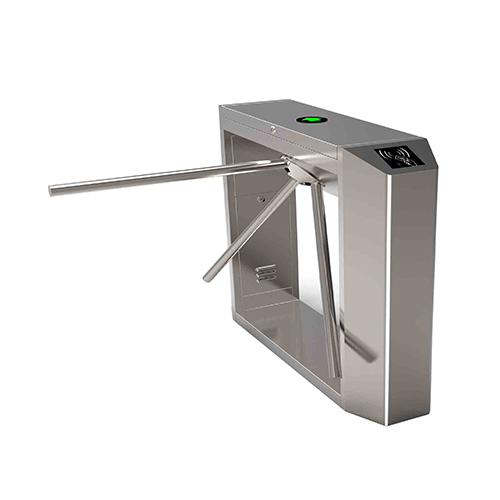
The brief description of the drwaings of a tripod turnstile security gate
A preferred embodiment will now be described wish reference to the accompanying drawings.
Fig. 1 is a diagrammatic, perspective view of a tripod turnstile security gate.
Fig. 2 is a partially diagrammatic lateral cross-section view showing a tripod turnstile mechanism for the turnstile illustrated in fig.1.
Fig. 3 is a diagrammatic partially cross-section horizontal view of the tripod turnstile mechanism according to fig. 2.
Fig. 4 is a side view in cross-section of the turnstile mechanism comprising a entry turnstile with tiltable barrier arms.
Fig. 5 is a horizontal view showing the tripod turnstile mechanism of fig. 4.
Fig. 6 is a partial side view in cross-section showing the arm carrier and its barrier arms.
Fig. 7 is a horizontal view showing the device in fig. 6.
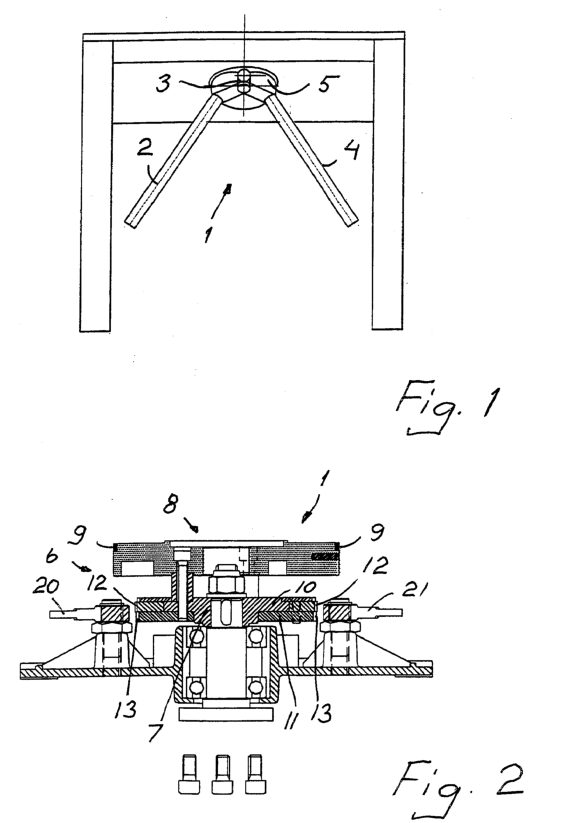
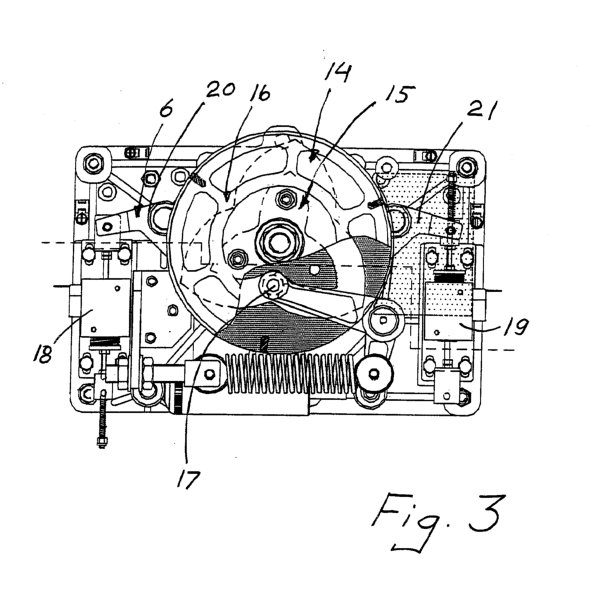
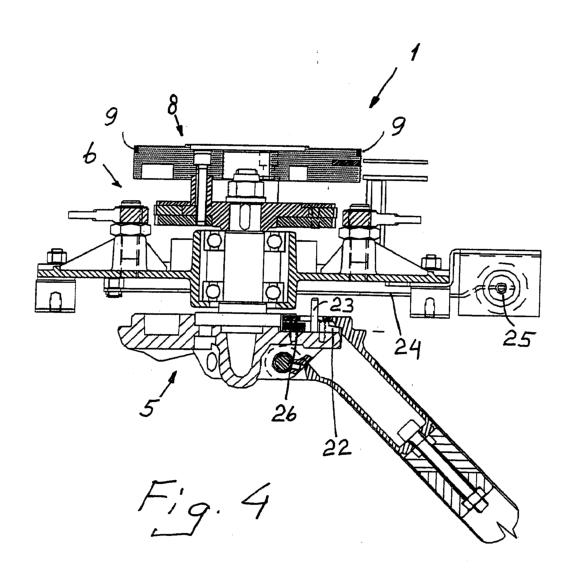
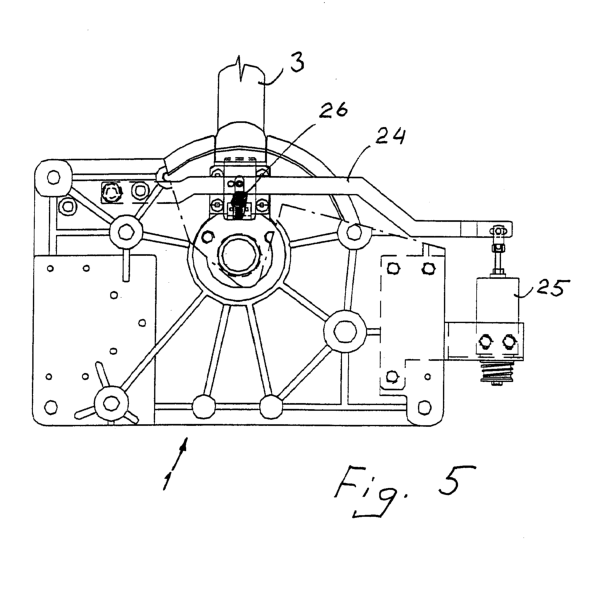
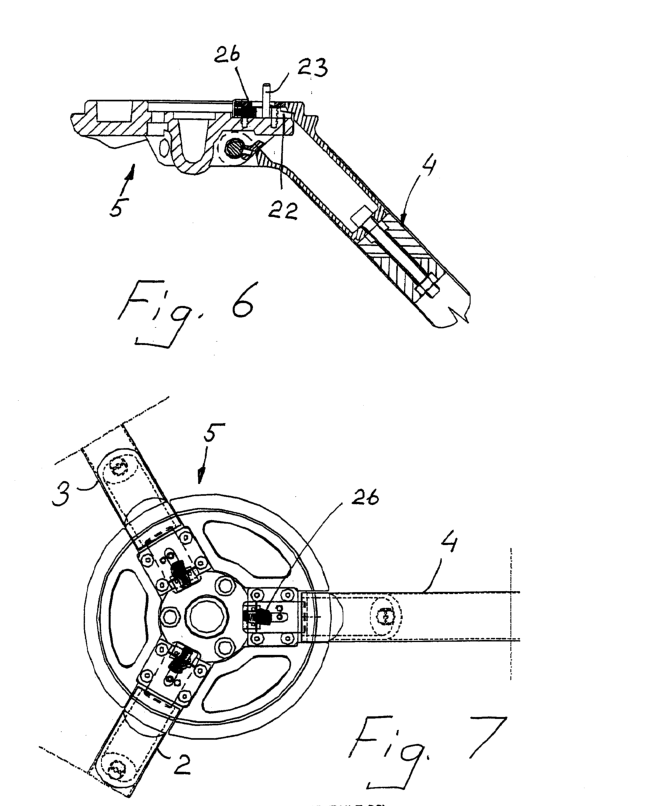
The detailed description of a tripod turnstile security gate
According to a preferred embodiment the tripod turnstile security gate 1 comprises three, at an equal angular distances arranged barrier arms 2, 3, 4. The barrier arms 2-4 are mounted on a rotable arm carrier 5 which by means of a remote control barrier device 6 can be locked to prevent or to permit, respectively, turning in at least one rotationally direction with the aid of a control disk7 situated above the arm carrier 5. Above the control disk 7 there is a home position 8 at the circumferentially of which there is secured a magnetic tape 9, for example in the form of an adhesive tape. This magnetic strip 9 is arranged to be scanned by aid of sensors not shown in the drawing, which can detect both the position and the direction of movement of the turnstile 1.
The control disk 7 consists of three parts, namely a core 10 made of metal, a locking disk 11 mounted below the core 10 and also consisting of a metallic material, and outer, circumferentially situated theeth 12 of a suitable flexible material, preferably rubber. The function of these teeth 12 is to observe the first portion of the kinetic of the autocontrol tripod turnstile 1 before it has brought to a complete stop by metallic teeth 13 on the locking disk 11.
The home position of the tripod turnstile security gate 1 are defined by a recess formation 14 with cam means 15 in connection to or formed in the control disk7 having a number of recesses 16 corresponding to the number of barrier arms 2-4. In the example chosen there are shown three triangular cam means 15 and, consenquently, three recesses 16, since the number of a barrier arms is three. A spring-biased positioning member 17 is derolled in contact with the cam means 15. The lock or barrier function of the control disk7 by means of the barrier device 6 is carried out by rocker arms 20, 21 activated upon by solenoids 18, 19 and cooperated with the teeth 12, 13 at the circumference of the disk 7. In addition to the spring-biased positioning members 17 for the fixation in there home positions of the barrier arms 2-4 of the turnstile1 hydraulic equipment can be used and the so-called home positions are reached when one of the barrier arms has assumed its horizontal orientation as mentioned above.
According to the preferred example the locking function of the device 16 is mechanically disconnected in a home position for any of the barrier arms 2-4 of the turnstile, also without an unaccepted signal, meaning that the turnstile is normally opened and that, upon acceptance or approval of a signal only the sensor system and the electronic system will check that the passage takes place and that the turnstile, by aid of the positioning member 17 assumes its next home position. The positioning system supplies a clear indication to the electronic system when efforts for unpermitted passage occurs, the solenoid concerned then being activated by the electronic system in order to prevent movement in the unpermitted direction but permit return to the initial position.
When desired the barrier arms 2-4 of the turnstile gate 1 can be tiltable as well. In that case each barrier arm is mounted in the arm carrier 5 and held in position there via a locking pin 23 in a locking bridge 22 for the barrier arms 2-4. The locking pin 23 can, for example at power failure or evacuation, be actuated by a spring-biased actuation arm 24, causing release of the arm concerned so that it falls from its horisontal position to an evacuation position. Accordingly, the solenoid 25 concerned is actuated by the electronic system, the spring load in the system resulting in that the actuation arm 24 is turning around its mounting point and then acts against the pin 23, mounted in the lock bridge 22 of the arm mechanism. The lock brigde 22 in turn is normally held in position by means of a recilent force, supplied by UA spring member 26 in the shape of a spring or a piece of rubber.
When resetting shall take place the solenoid 25 is automatically activated when the current returns or when the evacuation alarm is deactivated. The barrier arms 2-4 are then manually returned to their horizontal position where automatic locking takes place.

Claims
1. A tripod turnstile security gate comprising at three, at equiangular distances spaced barrier arms (2-4) on a rotable arm carrier (5) which by means of a remote-controlled barrier device (6) can be prevented or permitted, respectively, to turn in at least one turning direction, characterized in that the arm carrier (5), or at least one of a number of adjacent, rotatable disks (7; 8), has a preferably circumferentially extending magnetic tape (9) arranged, with the aid of sensors to indicate the position and the direction of movement of the turnstile (1), the bar function of the barrier device (6) being normally mechanically disconnected when one of the barrier arms (2-4) in the turnstile (1) is in its home position, i.e. when it is horizontally oriented, said sensor system and electronic means only establishing that a passage has taken place and that the turnstile (1) can„ when actuated upon by e.g. a spring or by hydraulic means, assume its next home position.
2. A three arm turnstile gate according to claim 1, characterized in that the magnetic strip (9) is supported by a home position disk (8) located above the arm carrier (5) between which there is a control disk (7) which in corporation with rocker arms (20, 21) actuated upon by solenoids (18, 19) form the barrier device (6).
3. A tripod turnstile gate system according to claim 1 or 2, characterized inthat the control disk (7) exhibits circumferental teeth (12, 13) both in the form of teeth (12) of flexible material, for example rubber, for the purpose of dampining the return of the turnstile (1) to the home positions for the barrier arms (2-4), and in the form of metallic teeths (13) designed to lock the turnstile (1).
4. A tripod barrier turnstile according to claim 1, characterized in thateach barrier arm (2-4) is pivotably mounted in the arm carrier (5) and there held in position via a lock pin (22) for each barrier arm (2-4) which pin, e.g. upon power failure, can be actuated by a spring-biased actuation on (24) resulting in that the barrier arm (24) concerned is released and falls from its horizontal position to an evacuation position.
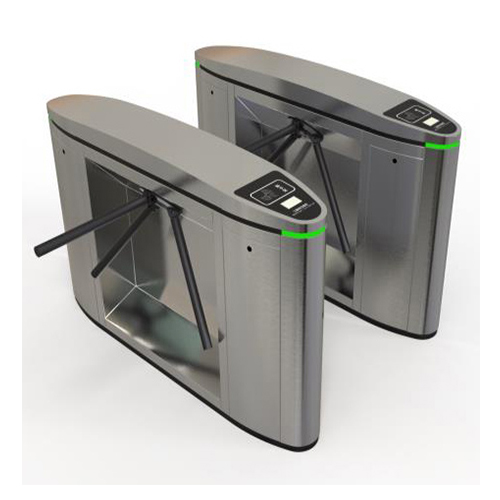
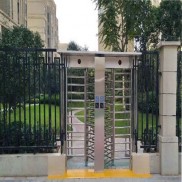 Double Lane Full Height Turnstile Gate for Residential Area
Double Lane Full Height Turnstile Gate for Residential Area
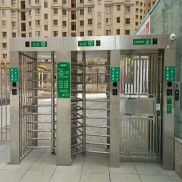 Dual Lane Tandem Full Height Turnstile Gate for Industry Park
Dual Lane Tandem Full Height Turnstile Gate for Industry Park
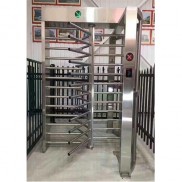 Single Full Height Security Turnstile for Office Buildings
Single Full Height Security Turnstile for Office Buildings
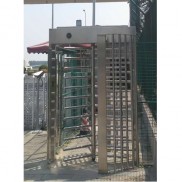 Motorised Double Full-Height Turnstile for Office Buildings
Motorised Double Full-Height Turnstile for Office Buildings







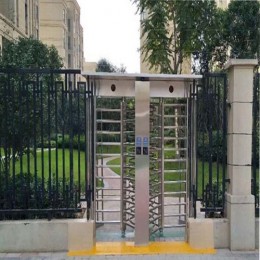
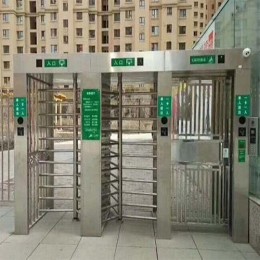









Please leave a message if you are interested in this model